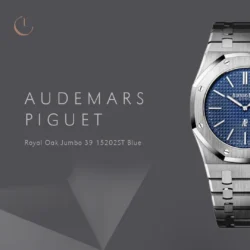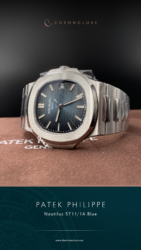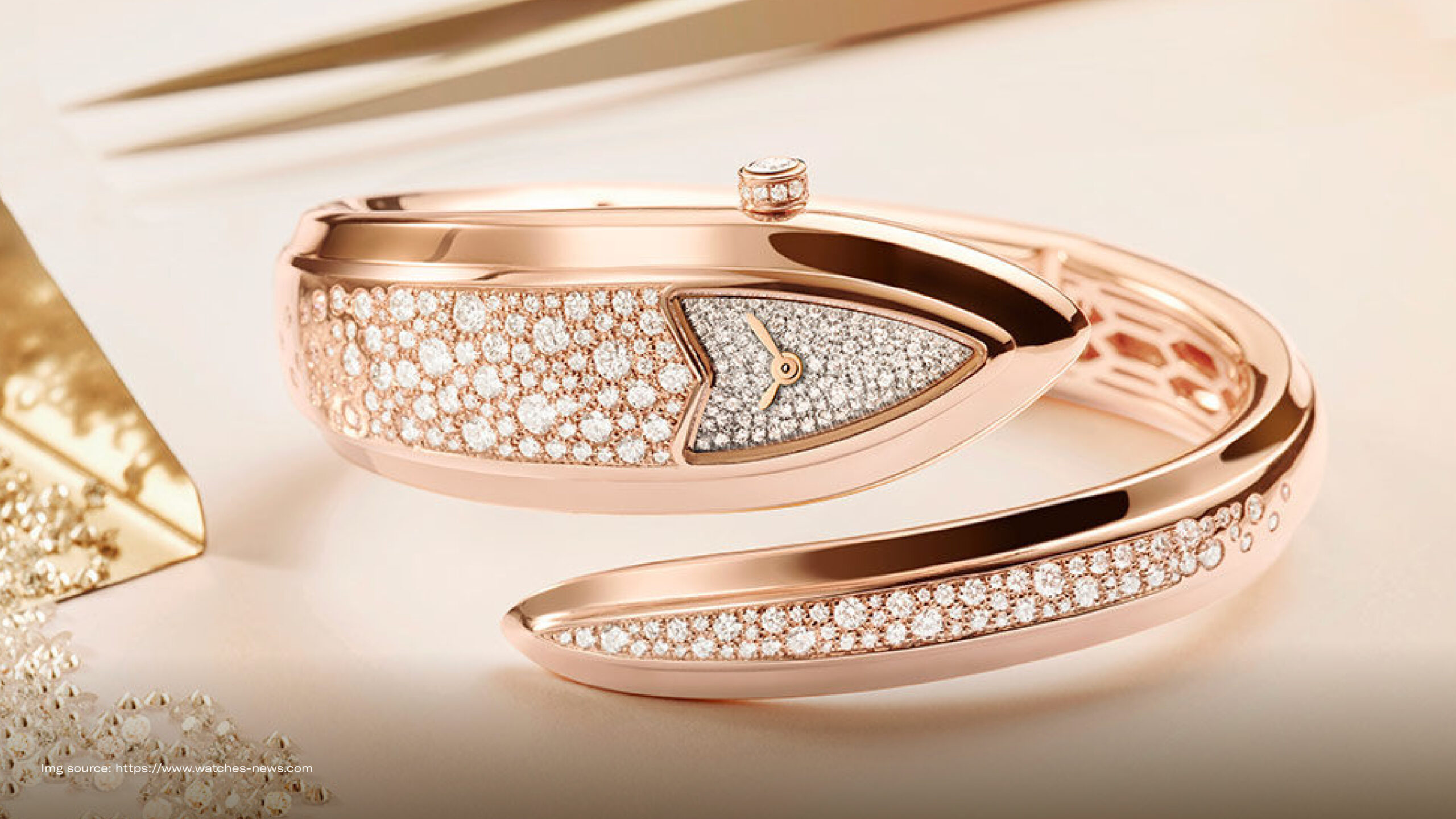Luxury timepieces like the Audemars Piguet Royal Oak and the Patek Philippe Nautilus epitomize excellence in craftsmanship, design, and exclusivity. Both watches, conceptualized by renowned designer Gérald Genta, have captivated horology enthusiasts for decades.
In this article, we dive deep into the differences between these two icons, covering design, movement, brand prestige, and model highlights to help collectors and aficionados understand what makes each watch distinct.
Let’s dive into our topic!
Table of Contents
ToggleDesign and Aesthetics
Introduced in 1972, the Audemars Piguet Royal Oak broke conventional watch design norms with its bold, industrial aesthetic. The standout feature is the octagonal bezel with eight exposed screws, lending a robust and daring look. The dial features the signature Tapisserie pattern, a geometric, textured design that adds depth and enhances the watch’s bold style. This waffle pattern sets it apart and emphasizes its unique visual character. The Royal Oak’s bracelet design is also notable for its thickness and sturdy construction, aligning perfectly with the watch’s overall industrial appeal.
The Patek Philippe Nautilus, launched in 1976, offers a smoother, more rounded design inspired by a ship’s porthole. While the Royal Oak has sharp, hard-edged lines, the Nautilus is characterized by softer, elegant contours that give it a refined look. Instead of the Tapisserie, the Nautilus dial features horizontally embossed bars, catching light to add sophistication. The Nautilus’s thin, refined bracelet adds a touch of understated elegance, complementing the watch’s smoother profile and making it a classic choice for those seeking a sleek yet luxurious appearance.
Movement and Mechanics
The Royal Oak is known for Audemars Piguet’s commitment to precision engineering and meticulous movement design. The watch boasts a robust construction with water resistance up to varying depths across models, ensuring durability without compromising style. Notably, it includes a compression-sealed water-resistant case, which maintains structural integrity under high pressures. This attention to detail extends to the movement, where Audemars Piguet employs high-quality finishing and advanced watchmaking techniques to deliver reliability and precision.
The Patek Philippe Nautilus is a testament to Patek Philippe’s heritage of artistry and functionality. Its automatic movements reflect the brand’s expertise in creating reliable, complex mechanisms that stand the test of time. A unique feature of the Nautilus is its crown guard, an added layer of protection that enhances the watch’s durability. Patek Philippe’s movements are celebrated for their aesthetic beauty, with fine engravings and detailed finishes that are visible in models with an open case back. These mechanics make the Nautilus not only a timekeeping tool but a piece of horological art.
Brand Prestige
Audemars Piguet is credited with pioneering the luxury sports watch segment through the Royal Oak’s introduction during the Quartz Crisis in the 1970s. The Royal Oak stood out as the first high-end sports watch crafted from stainless steel, a bold move at a time when luxury typically meant precious metals. This groundbreaking approach has cemented the Royal Oak’s place as a symbol of innovation, attracting a loyal following and defining the brand as a leader in horological advancement.
Patek Philippe, a watchmaker with a deep legacy, positions the Nautilus as a symbol of timeless elegance. The brand is synonymous with exclusivity, and the Nautilus further solidifies this reputation. Patek Philippe’s commitment to complex watchmaking, including highly complicated timepieces, makes the Nautilus especially appealing to collectors seeking both luxury and intricate craftsmanship. The brand’s philosophy of creating heirloom-quality watches adds a unique allure, as each timepiece is crafted to be passed down through generations.
Popular Models and Variants
1. Royal Oak Jumbo (Ref. 15202ST)

The Royal Oak Jumbo is a hallmark of Audemars Piguet’s craftsmanship, celebrated for its ultra-thin profile. This model retains the essence of the original 1972 design while incorporating modern upgrades. Key features include:
- Case: Stainless steel, 39 mm diameter, 8.1 mm thickness, water-resistant up to 50 m.
- Dial: Blue “Petite Tapisserie” pattern with white gold hour markers and luminescent hands.
- Movement: Powered by Calibre 2121, a self-winding movement with a power reserve of approximately 40 hours.
- Bracelet: Integrated stainless steel bracelet with an AP folding clasp.
This model is particularly revered for its sleek design and is often considered the quintessential Royal Oak.
2. Royal Oak Offshore
Introduced in 1993, the Royal Oak Offshore is a bolder, sportier iteration of the original Royal Oak. It features a larger case and a more robust aesthetic, making it ideal for those seeking a statement piece. Notable characteristics include:
- Case: Typically larger than the original at around 42 mm, crafted from various materials including stainless steel and titanium.
- Dial: Varied designs depending on the model, often with chronograph functions and bold colors.
- Movement: Various calibers are used; many models feature automatic movements with significant power reserves.
- Bracelet: Rubber straps or integrated metal bracelets enhance its sporty appeal.
The Offshore line has become synonymous with luxury sports watches that combine durability with high-end design.
3. Royal Oak Tourbillon
The Royal Oak Tourbillon exemplifies Audemars Piguet’s technical prowess by integrating the intricate complications of a tourbillon into the classic design. Key specifications include:
- Case: Available in various materials such as rose gold or platinum, typically around 41 mm in size.
- Dial: Often features a “Tapisserie” pattern with exposed tourbillon at 6 o’clock.
- Movement: Houses a finely crafted tourbillon movement, showcasing superior craftsmanship and precision.
- Bracelet: Usually features an integrated bracelet that matches the case material.
This model appeals to collectors who appreciate both artistry and horological complexity.
4. Nautilus 5711/1A

The Nautilus 5711/1A is perhaps the most iconic model in Patek Philippe’s collection, known for its stunning blue dial and elegant design. Key features include:
- Case: Stainless steel, 40 mm diameter, water-resistant up to 120 m.
- Dial: Blue with horizontal embossing and white gold hour markers.
- Movement: Equipped with Calibre 324 S C, a self-winding movement with a power reserve of about 35 to 45 hours.
- Bracelet: Integrated stainless steel bracelet that complements its sleek profile.
This model is highly sought after by collectors due to its classic aesthetic and limited availability.
5. Nautilus Chronograph (Ref. 5980)
The Nautilus Chronograph (Ref. 5980) combines functionality with elegance, featuring a chronograph complication that adds to its versatility. Key specifications include:
- Case: Stainless steel or rose gold options are available, typically around 40.5 mm in size.
- Dial: Available in various colors; often features sub-dials for chronograph functions.
- Movement: Powered by Calibre CH 28-520 C, which includes both automatic winding and chronograph functions.
- Bracelet: Integrated bracelet matching the case material.
This model is perfect for those who appreciate both style and functionality in their timepieces.
6. Nautilus Annual Calendar (Ref. 5800)
The Nautilus Annual Calendar (Ref. 5800) blends practicality with sophisticated design. Key features include:
- Case: Stainless steel or rose gold options, typically around 40 mm in diameter.
- Dial: Features an annual calendar display with separate apertures for date and month indicators.
- Movement: Uses Calibre 324 S QA LU, which provides an annual calendar function along with self-winding capabilities.
- Bracelet: Integrated bracelet that enhances its overall aesthetic appeal.
This model showcases Patek Philippe’s dedication to combining functionality with elegance in watchmaking.
Conclusion
The Royal Oak and Nautilus have each made an indelible mark on horology, appealing to collectors for their unique characteristics and historical significance. Audemars Piguet’s Royal Oak is often seen as the more daring choice, perfect for individuals who admire bold design and innovative approaches in the luxury sports watch segment. The Nautilus, meanwhile, offers timeless elegance and sophistication, appealing to those who value refinement and understated luxury.
Ultimately, choosing between the Audemars Piguet Royal Oak and the Patek Philippe Nautilus comes down to personal preference and lifestyle. Both watches represent the pinnacle of luxury and craftsmanship, yet each offers a unique aesthetic and appeal. The Royal Oak’s bold, industrial design contrasts with the Nautilus’s smooth, elegant contours, providing diverse options for different tastes.
For those who prioritize innovation and a daring aesthetic, the Royal Oak is an excellent choice. Alternatively, if you lean towards a watch with classic elegance and refined details, the Nautilus stands as a perfect option.
Find the perfect luxury watch collection for you at Luxehouze, the best place to discover timeless luxury watches of unparalleled quality.
Luxehouze offers a variety of luxury watches, including brands like Rolex, Patek Philippe, Richard Mille, and many more.
All available watches are 100% authentic and can be acquired at the best prices. Visit the Luxehouze boutiques in Jakarta, Surabaya, and Singapore to explore the masterpiece watches you’ve always dreamed of!













